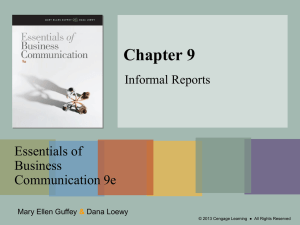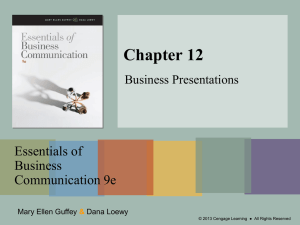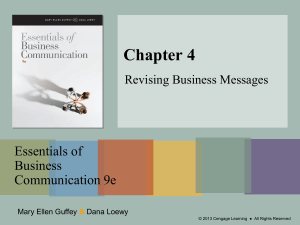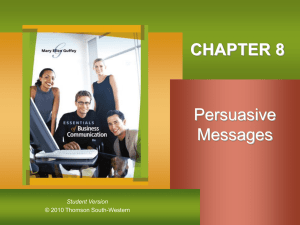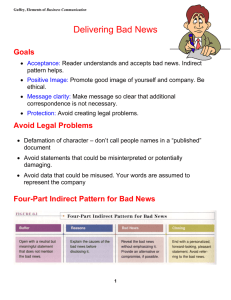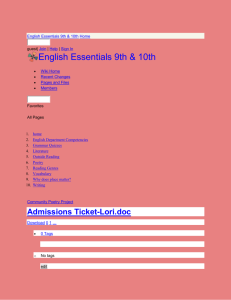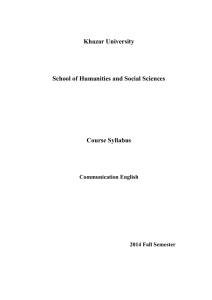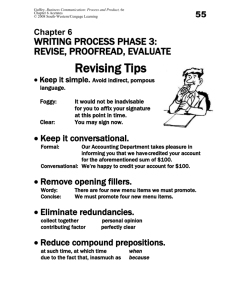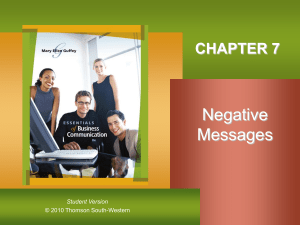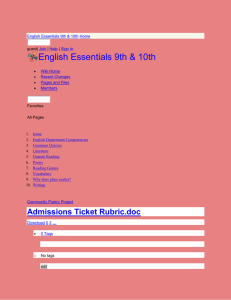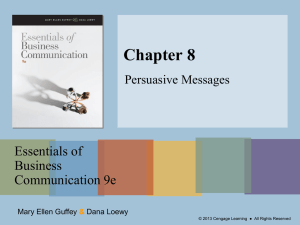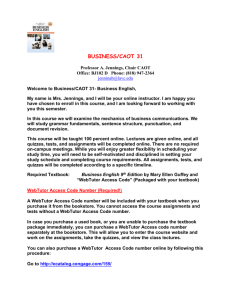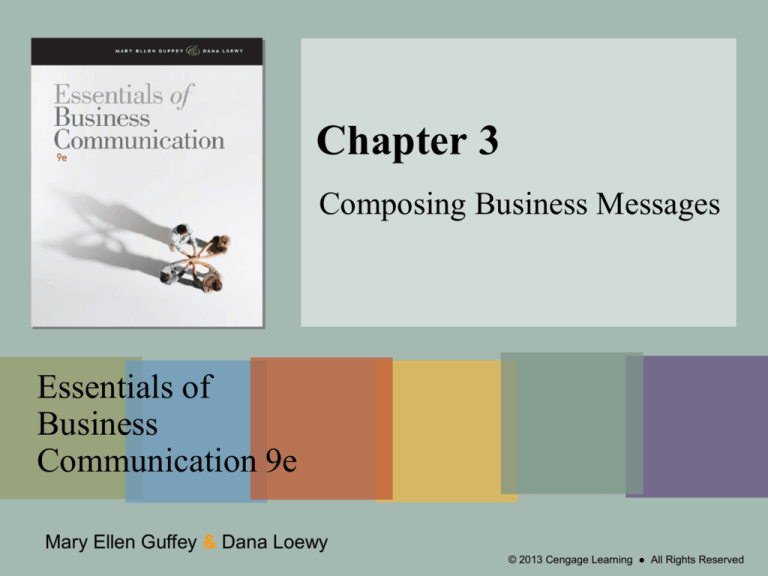
Chapter 3
Composing Business Messages
Essentials of
Business
Communication 9e
Mary Ellen Guffey & Dana Loewy
© 2013 Cengage Learning ● All Rights Reserved
The Writing Process
© 2013 Cengage Learning ● All Rights Reserved
Mary Ellen Guffey & Dana Loewy, Essentials of Business Communication, 9th Edition
Chapter 3, Slide 2
© 2013 Cengage Learning ● All Rights Reserved
Phase 2 of
the Writing
Process
Mary Ellen Guffey & Dana Loewy, Essentials of Business Communication, 9th Edition
Chapter 3, Slide 3
Phase 2: Researching
Formal Research
Methods
© 2013 Cengage Learning ● All Rights Reserved
Search manually.
Access electronically.
Go to the source.
Conduct scientific
experiments.
Informal Research
Methods/Idea Generation
Look in the files.
Talk with your boss.
Interview the target
audience.
Conduct an informal
survey.
Brainstorm ideas.
Mary Ellen Guffey & Dana Loewy, Essentials of Business Communication, 9th Edition
Chapter 3, Slide 4
Phase 2: Organizing
© 2013 Cengage Learning ● All Rights Reserved
Organizing
Business
Messages
DIRECT STRATEGY
Main idea comes
first followed by
details and explanations
Mary Ellen Guffey & Dana Loewy, Essentials of Business Communication, 9th Edition
Chapter 3, Slide 5
© 2013 Cengage Learning ● All Rights Reserved
Mary Ellen Guffey & Dana Loewy, Essentials of Business Communication, 9th Edition
Chapter 3, Slide 6
Phase 2: Organizing
© 2013 Cengage Learning ● All Rights Reserved
Organizing
Business
Messages
Explanation precedes
main idea
INDIRECT STRATEGY
Mary Ellen Guffey & Dana Loewy, Essentials of Business Communication, 9th Edition
Chapter 3, Slide 7
© 2013 Cengage Learning ● All Rights Reserved
Mary Ellen Guffey & Dana Loewy, Essentials of Business Communication, 9th Edition
Chapter 3, Slide 8
Phase 2: Composing
Business writers must be able to:
Develop effective sentences.
Improve writing techniques.
© 2013 Cengage Learning ● All Rights Reserved
Draft powerful paragraphs.
Compose a first draft.
Mary Ellen Guffey & Dana Loewy, Essentials of Business Communication, 9th Edition
Chapter 3, Slide 9
Effective Sentences
Complete
Sentences
Clauses
Phrases
© 2013 Cengage Learning ● All Rights Reserved
Complete sentences have subjects
and verbs and make sense
(are capable of standing alone).
subject
verb
Employees send many e-mail messages.
Mary Ellen Guffey & Dana Loewy, Essentials of Business Communication, 9th Edition
Chapter 3, Slide 10
Effective Sentences
Complete
Sentences
Clauses
Phrases
© 2013 Cengage Learning ● All Rights Reserved
Clauses also have subjects and verbs.
Independent clauses can stand alone.
Dependent clauses rely on independent
clauses for their meaning.
dependent clause
independent clause
When you speak, you reveal yourself.
Mary Ellen Guffey & Dana Loewy, Essentials of Business Communication, 9th Edition
Chapter 3, Slide 11
Effective Sentences
Complete
Sentences
Clauses
Phrases
© 2013 Cengage Learning ● All Rights Reserved
Phrases are groups of related
words without subjects and verbs.
phrase
phrase
In the afternoon, I work at the mall.
Mary Ellen Guffey & Dana Loewy, Essentials of Business Communication, 9th Edition
Chapter 3, Slide 12
Effective Sentences
Use four sentence types to achieve variety.
© 2013 Cengage Learning ● All Rights Reserved
Simple sentence (one independent clause)
LinkedIn decided to sell its stock to the public.
Compound sentence (two independent clauses)
The company went public, and the price per
share doubled the first day.
Complex Sentence (one independent and one dependent clause)
Because LinkedIn’s IPO was so successful, the entire stock market
went up.
Compound-complex sentence (at least two independent clauses
and one dependent clause)
Although many investors bought LinkedIn stock the first day, some
were disappointed; however, they were able to purchase shares
shortly after.
Mary Ellen Guffey & Dana Loewy, Essentials of Business Communication, 9th Edition
Chapter 3, Slide 13
Effective Sentences
Avoid three common sentence faults.
1. Fragment
Even though the pay was low. Many candidates applied.
© 2013 Cengage Learning ● All Rights Reserved
Revision:
Even though the pay was low, many candidates applied.
2. Run-on (fused) sentence
Two candidates applied only one was hired.
Revisions:
Two candidates applied. Only one was hired.
Two candidates applied; only one was hired.
Two candidates applied, but only one was hired.
Mary Ellen Guffey & Dana Loewy, Essentials of Business Communication, 9th Edition
Chapter 3, Slide 14
Effective Sentences
Avoid three common sentence faults.
3. Comma Splice
Many were qualified, Jeff was hired.
© 2013 Cengage Learning ● All Rights Reserved
Revisions:
Many were qualified. Jeff was hired.
Many were qualified; Jeff was hired.
Many were qualified; however, Jeff was hired.
Many were qualified, but Jeff was hired.
Mary Ellen Guffey & Dana Loewy, Essentials of Business Communication, 9th Edition
Chapter 3, Slide 15
Improving Writing Techniques
Achieve emphasis through mechanics.
Underlining:
Which of these methods do you prefer?
Italics and Boldface:
The use of boldface and italics captures the reader’s attention.
© 2013 Cengage Learning ● All Rights Reserved
All Caps:
Notice how EXPENSE-FREE VACATION stands out.
Dashes:
Other methods–including dashes–may be used.
Tabulation: Listing items vertically emphasizes them.
1. First item
2. Second item
3. Third item
Mary Ellen Guffey & Dana Loewy, Essentials of Business Communication, 9th Edition
Chapter 3, Slide 16
Improving Writing Techniques
Achieve emphasis through style.
© 2013 Cengage Learning ● All Rights Reserved
To emphasize an idea
Use a vivid expression, such as in error-free document rather than
good document.
Label the idea with expressions such as more important, the principal
reason, or the best alternative.
Put the important idea first or last in the sentence.
Put the important idea in a simple sentence or independent clause.
To de-emphasize an idea
Use general, rather than specific, words (some customers
complained, rather than 125 customers complained).
Place the idea in a dependent clause connected to an independent
clause containing a positive idea.
Although items cannot be returned for cash, you will receive store
credit for any returns.
Mary Ellen Guffey & Dana Loewy, Essentials of Business Communication, 9th Edition
Chapter 3, Slide 17
Improving Writing Techniques
Use active- and passive-voice verbs.
Active-voice verbs show the subject
performing the action.
Use active voice for most business writing.
© 2013 Cengage Learning ● All Rights Reserved
Most major employers provide health insurance.
(Active voice; the subject is acting)
Latoya submitted her report on time.
(Active voice; the subject is acting)
Mary Ellen Guffey & Dana Loewy, Essentials of Business Communication, 9th Edition
Chapter 3, Slide 18
Improving Writing Techniques
Use active- and passive-voice verbs.
© 2013 Cengage Learning ● All Rights Reserved
In passive-voice sentences, the subject is being
acted upon. Passive-voice verbs require helper
verbs.
Use the passive voice to emphasize an action or
the recipient of the action and to deliver bad news.
Health insurance is provided by most major employers.
(Passive voice; the subject is being acted upon)
The report was submitted on time by Latoya.
(Passive voice; the subject is being acted upon)
Mary Ellen Guffey & Dana Loewy, Essentials of Business Communication, 9th Edition
Chapter 3, Slide 19
Improving Writing Techniques
Develop parallelism, balanced construction.
Match nouns with nouns, verbs with verbs,
phrases with phrases, and clauses with clauses.
© 2013 Cengage Learning ● All Rights Reserved
Poor
Training sessions
have been stimulating and a challenge.
Parallel
Training sessions
have been stimulating and challenging.
(Matches -ing verbals)
Mary Ellen Guffey & Dana Loewy, Essentials of Business Communication, 9th Edition
Chapter 3, Slide 20
Improving Writing Techniques
Avoid dangling and misplaced modifiers. For clarity,
modifiers must be close to the words they describe or limit.
© 2013 Cengage Learning ● All Rights Reserved
Poor
Improved
After considering the
problem carefully,
new procedures
were suggested by
management.
After considering the
problem carefully,
management
suggested new
procedures.
Mary Ellen Guffey & Dana Loewy, Essentials of Business Communication, 9th Edition
Chapter 3, Slide 21
Drafting Powerful Paragraphs
A paragraph is a group of sentences about one idea.
Paragraphs are most effective when they contain:
A topic sentence
Support sentences that expand and explain the main idea
Techniques to build coherence
© 2013 Cengage Learning ● All Rights Reserved
Achieve paragraph coherence by using one of these
devices:
Repeat a key idea or key words.
Use a pronoun.
Use an appropriate transitional expression.
Mary Ellen Guffey & Dana Loewy, Essentials of Business Communication, 9th Edition
Chapter 3, Slide 22
Composing the First Draft
© 2013 Cengage Learning ● All Rights Reserved
Complete all necessary research.
Find a quiet place to concentrate and
work.
Prohibit calls, visitors, and interruptions.
Organize information into an outline.
Decide whether to write quickly
(freewriting) OR revise as you go.
Imagine you are talking to
a reader or listener.
Mary Ellen Guffey & Dana Loewy, Essentials of Business Communication, 9th Edition
Chapter 3, Slide 23
END
Essentials of
Business
Communication 9e
Mary Ellen Guffey & Dana Loewy
© 2013 Cengage Learning ● All Rights Reserved

